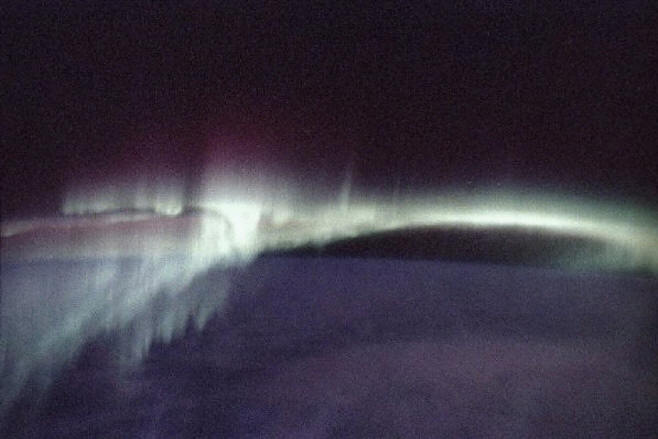Things that Go Bump in the Light
Jul
06, 2010
The northern aurora contains
regions that sometimes emit
energetic bursts of light.
"It seems to be a natural
consequence of our points of view to
assume that the whole of space is
filled with electrons and flying
electric ions of all kinds."
--- Kristian Birkeland
The curtains of blue, green, and red
that hang down from the sky like
wind-wavering veils of color have
both puzzled and entranced observers
for countless millennia. In 1621,
Pierre Gassendi called the
shimmering curtains of light seen in
the Arctic the Aurora Borealis after
Aurora, the Roman goddess of dawn,
and Boreas, the Greek name for the
north wind.
Earth possesses a complex
electrically active structure called
a magnetotail (or plasma tail) that
extends for millions of kilometers,
always pointed away from the Sun.
Streams of charged particles ejected
from the Sun, conventionally called
the solar wind, are captured by our
planet's magnetosphere, and along
with ions generated by Earth itself,
collect in a plasma sheet within the
magnetotail, where they are held
together by Earth's magnetic field.
Solar ions follow Earth's magnetic
field down into the poles, causing
atmospheric molecules to emit light:
red from oxygen at high altitudes,
then green from oxygen lower down,
along with blue from nitrogen.
According to a
press release from NASA's Time
History of Events and Macroscale
Interactions during Substorms (THEMIS)
mission, large areas of the Aurora
Borealis are sometimes seen to
create intense bursts of light
called substorms. Such bursts have
long been a puzzle to
astrophysicists, but now team
members think they finally have a
solution: "plasma bullet
collisions."
THEMIS scientists propose that
small, fast-moving aurorae "crash
into" the large-scale auroral
complex that moves slowly. An
auroral "knot" of plasma speeds in
from the north and the two
formations collide, releasing an
abrupt flash.
How is Earth's magnetotail involved
in these "collisions?"
Larry Lyons of UCLA, one of the
team's leading researchers, believes
that the knots move in conjunction
with a plasma jet traveling through
the magnetotail. Plasma waves and
instabilities are generated when the
jet reaches the magnetotail's inner
boundary. Radar stations in Alaska
and Greenland have detected return
signals from streams of plasma in
Earth's upper atmosphere just before
the aurorae collide.
The five
THEMIS spacecraft repeatedly fly
through the magnetotail and have
also confirmed the existence of
plasma streams speeding toward
Earth. It is those packets of field
aligned charged particles that are
called plasma bullets.
Strong electromagnetic disturbances
are observed when a bright aurora is
seen. In 1903, Kristian Birkeland's
Arctic expedition discovered that
electric currents from the Aurora
Borealis flowed parallel to the
auroral formation. Since electric
currents move in a circuit, and
since the auroral glow seemed to be
caused by events in space, he
proposed that the currents flowed
down from space at one end of the
auroral arc and back out to space at
the other.
In 1973, the magnetometer
aboard the U.S. Navy satellite Triad
found two gigantic electric current
sheets carrying a million amperes or
more. One plasma sheet descended
from the aurora's morning side and
the other ascended from the evening
side. Since Birkeland's research
predicted those currents linking
Earth with space, they are called
Birkeland currents.
Today, Birkeland's polar electric
currents are known as auroral
electrojets; they are connected to
electric currents that follow the
geomagnetic field into and away from
the Arctic region. They are the
"new" discovery made by NASA
scientists who continue to ignore
Birkeland's work. Although the words
"plasma" and "currents" are used in
the press release, they are coupled
with "impacts," "collisions," and
"streams."
The light bursts from colliding
aurorae are said to be the result of
"magnetic reconnection" events. As
the theory states, the solar wind
"stretches" our magnetic field like
a rubber band. When it "snaps back"
the over-stretched magnetic field
lines initiate a powerful explosion
when some of the "magnetic energy"
is converted to heat and light.
As
was discussed in a previous Picture
of the Day, how the energy is
released, as well as what starts the
process, are still controversial
subjects. Energy in nature cannot be
destroyed, as the conservation of
energy law states. When electricity
powers a motor, it is converted to
kinetic energy. When friction stops
motion, its kinetic energy converts
to heat. Magnetic energy is also
thought to reappear in different
forms. Some becomes heat, increasing
the velocity of plasma ions and
electrons. Some changes to visible
light.
Again it seems that space scientists
are reversing cause (electric
currents) and effect (magnetic
fields). They downplay or deny the
importance of the electrical
processes and ignore the work of
plasma pioneers like Kristian
Birkeland. New discoveries are
really confirming the experiments
done by others more than 100 years
ago.
Stephen Smith







